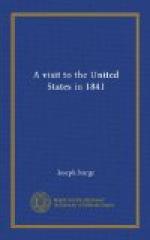[Footnote A: See Appendix D for a brief account of this ancient philanthropist.]
As the old school of abolitionists has been mentioned, and will occasionally be referred to hereafter, the following historical statement of its rise and decline, and of the commencement of the present abolition movement, will probably be interesting to the anti-slavery reader on this side of the Atlantic. It is from the pen of my valued coadjutor John G. Whittier.
“The old Anti-Slavery Societies, established about the period of the American Revolution, and of which the late Judge Jay, Benjamin Franklin, Dr. Rush, and other distinguished statesmen were members, were composed mainly of the Religious Society of Friends. These societies were for many years active and energetic in their labors for the slave, and the free people of color; and little, if any, serious opposition was made to their exertions, which indeed seem to have been confined to the particular states in which they were located. They rendered essential service in promoting the gradual abolition of slavery in New York, Pennsylvania, and New Jersey.
“In 1819 commenced the discussion of what is now known as the ‘Missouri Question.’ The Anti-Slavery Societies took ground against the admission into the Union of the territory of Missouri as a slave state. They succeeded in arousing the public attention; and for two sessions the subject was warmly debated in Congress; the slave-holders finally carrying their point by working upon the fears of a few Northern members, by means of that old threat of dissolving the Union, which in the very outset of the Government had extorted from the Convention which framed the Constitution, a clause legalizing the Foreign Slave Trade for twenty years. The admission of Missouri as a slave State was a fatal concession to the South: the abolitionists became disheartened: their societies lingered on a few years longer, and nearly all were extinct previous to 1830. The colonization scheme had in the mean time, in despite of the earnest and almost unanimous rejection of it by the colored people, obtained a strong hold on the public mind, and had especially enlisted the favorable regard of some of the leading influences of the Society of Friends. Here and there over the country, might be found still a faithful laborer, like Elisha Tyson, of Baltimore, Thomas Shipley, of Philadelphia, and Moses Brown, of Rhode Island, holding up the good old testimony against prejudice and oppression in the midst of a wide spread apostacy. I should mention in this connection, Benjamin Lundy, a member of the Society of Friends, who devoted his whole life to the cause of freedom, travelling on foot thousands of miles, visiting every part of the slave States, Mexico and the Haytian Republic. About the year 1828, he visited Boston, and enlisted the sympathies of William Lloyd Garrison, then a very young man. Not long after, he was joined by the latter as an associate editor of




